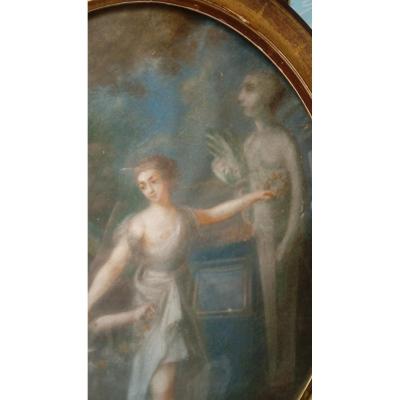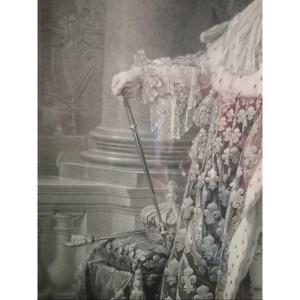Transition period, circa 1770.
Oak frame; Rosewood ; amaranth; maple; holly tinted green; chiseled and gilded bronze; marble.
STAMP: C.L.COSTE/JME, under the tray on the left front upright.
Characteristic of the Transition style, this exceptional chest of drawers, with a rectangular oak frame with a facade divided into three parts, was made around 1770 by Charles Louis Coste (master in 1784). It bears the C.L.COSTE stamp and is flanked by the JME jurande hallmark, the latter stamped and visible on the front left upright of the piece of furniture. Honoring the talent of the craftsman with the accuracy of the proportions and the elegance of the bronzes, it presents, on a background of rosewood veneer arranged in an “X” highlighted with amaranth borders and scraps, sumptuous marquetry panels in green-tinted maple and holly wood with a central decoration of an openwork basket of flowers framed by antique-style vases also decorated with flowers - a model of neoclassical marquetry worthy of the greatest achievements of the second half of the 18th century - with rectilinear frames enhanced with tripartite amaranth fillets lined with broken maple fillets at the corners and in the center of a square (two squares for the main frame) itself detailed with nine small squares alternating the same species. The marquetry panels on the short sides feature the same framing design inside which extraordinary floral compositions with a naturalistic rendering stand out. Real “wood paintings”, these decorations are made up of small pieces of varied species, natural or tinted in color, which are cut with a saw then inlaid into the background using a knife. Details are obtained by saw engraving during cutting and modeling by sand shading.
The subtlety of this work was completed by saw engraving to trace the details of the leaves and petals. We easily recognize the different specimens represented: roses in bloom, tulips, daffodils and daisies. The finesse of the marquetry decoration perfectly reflects the heritage of the specialist in the field: Jean-François Œben (around 1720-1763, master in 1760), “cabinetmaker and mechanic to the King”. Sir Geoffrey de Bellaigne demonstrated that the latter's floral marquetry was very probably inspired, among others, by the engravings of Juste Chevillet (1729-1802) for the Livre de Principes de Fleurs, made after the drawings of Louis Tessier (c. 1719-1781), one of the flower painters at the Gobelins factory. Coste nevertheless distinguished himself from him by engaging in a fairly free interpretation of these models, which makes comparison with existing engravings difficult. Now patinated with time, the colors of the marquetry of this chest of drawers were lively and contrasting.
It opens with three rows of drawers: two large drawers without crossbars and three small drawers in the belt. The whole thing is controlled by a single key. Two chiseled and gilded bronze pull rings are fixed on the large drawers while the two small drawers at the ends are decorated with a ring due to their size. We can, without too much difficulty, put forward the idea that the absence of the pellets on the gilded bronze handles can be explained by the choice to leave the decoration of the inlaid panels free. The piece of furniture is distinguished by its gilded bronze ornamentation composed of scraps decorated with flutes, laurel garland and base of acanthus leaves in the style generally attributed to the famous architect and ornamentalist Jean-Charles Delafosse (1734-1789), and rests on four arched legs with curved edges, the front legs of which are decorated with clawed hooves with acanthus foliage supported by scrolls. The rectilinear lower cutout is interrupted in the center of the main face by a cul-de-lamp pattern of a lidded casserole dish attached by the handles to acanthus leaves by a laurel garland, a model that can be found on many beautiful creations by Parisian cabinetmakers around 1770. Small gilded bronze motifs, drawing garlands of laurels attached at the top and bottom, adorn the three keyholes, the bottom one being devoid of falls. A marble top, with a linear cut and molded border, crowns it all.
The gilded bronzes adorning our chest of drawers belong resolutely to the neoclassical repertoire, thus allowing us to date the piece of furniture in fact around 1770. The pull rings without pastille and base of cassolette lamp, acanthus leaves and laurel garland, correspond to leafy clogs with claws which we find, for example, in no way part of the same body of furniture, on a luxurious anonymous chest of drawers, of similar dimensions, inlaid with decoration of “intertwined hearts and diamonds”, classified in title of historical monuments by decree of May 26, 1937 and preserved in the central body of the large cabinet of the private apartments of Madame du Barry at the Palace of Versailles (inv. OA 5197). Another anonymous chest of drawers with almost identical dimensions, presenting the same falls, the same handles and a three-part front in flower marquetry, is also on display at the Palace of Versailles (inv. VMB 14275). We can therefore easily assume that Coste in no way neglected the choice of decorations in chiseled and gilded bronze, ornaments to which he probably assigned a role of primary importance, and called on specialists in the field for this.
Charles Louis Coste
Few pieces of furniture remain today from Charles Louis Coste, who received his master's degree on January 16, 1784. An intimate craftsman revealing in each creation a work of very high quality in cabinetmaking, he lived on rue Saint-Nicolas then, after the Revolution , rue de Charenton. His name is still mentioned at the end of the Empire in 1815. We can therefore assume from this information that our piece of furniture was among his first creations.
BIBLIOGRAPHY: Sylvie Legrand-Rossi, The Furniture of the Nissim de Camondo Museum, Dijon, Éditions Faton, 2012.
Good general condition, usual restorations and maintenance.
THANK YOU to Thomas Delage for the research and the perfect description of this very beautiful chest of drawers.












































 Le Magazine de PROANTIC
Le Magazine de PROANTIC TRÉSORS Magazine
TRÉSORS Magazine Rivista Artiquariato
Rivista Artiquariato